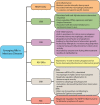Macrophage nuclear receptors: Emerging key players in infectious diseases
- PMID: 30897154
- PMCID: PMC6428245
- DOI: 10.1371/journal.ppat.1007585
Macrophage nuclear receptors: Emerging key players in infectious diseases
Abstract
Nuclear receptors (NRs) are ligand-activated transcription factors that are expressed in a variety of cells, including macrophages. For decades, NRs have been therapeutic targets because their activity can be pharmacologically modulated by specific ligands and small molecule inhibitors. NRs regulate a variety of processes, including those intersecting metabolic and immune functions, and have been studied in regard to various autoimmune diseases. However, the complex roles of NRs in host response to infection are only recently being investigated. The NRs peroxisome proliferator-activated receptor γ (PPARγ) and liver X receptors (LXRs) have been most studied in the context of infectious diseases; however, recent work has also linked xenobiotic pregnane X receptors (PXRs), vitamin D receptor (VDR), REV-ERBα, the nuclear receptor 4A (NR4A) family, farnesoid X receptors (FXRs), and estrogen-related receptors (ERRs) to macrophage responses to pathogens. Pharmacological inhibition or antagonism of certain NRs can greatly influence overall disease outcome, and NRs that are protective against some diseases can lead to susceptibility to others. Targeting NRs as a novel host-directed treatment approach to infectious diseases appears to be a viable option, considering that these transcription factors play a pivotal role in macrophage lipid metabolism, cholesterol efflux, inflammatory responses, apoptosis, and production of antimicrobial byproducts. In the current review, we discuss recent findings concerning the role of NRs in infectious diseases with an emphasis on PPARγ and LXR, the two most studied. We also highlight newer work on the activity of emerging NRs during infection.
Conflict of interest statement
The authors have declared that no competing interests exist.
Figures



Similar articles
-
The role of lipid-activated nuclear receptors in shaping macrophage and dendritic cell function: From physiology to pathology.J Allergy Clin Immunol. 2013 Aug;132(2):264-86. doi: 10.1016/j.jaci.2013.05.044. J Allergy Clin Immunol. 2013. PMID: 23905916 Review.
-
The nuclear receptor Rev-erbalpha is a liver X receptor (LXR) target gene driving a negative feedback loop on select LXR-induced pathways in human macrophages.Mol Endocrinol. 2008 Aug;22(8):1797-811. doi: 10.1210/me.2007-0439. Epub 2008 May 29. Mol Endocrinol. 2008. PMID: 18511497 Free PMC article.
-
Nuclear receptors in the kidney during health and disease.Mol Aspects Med. 2021 Apr;78:100935. doi: 10.1016/j.mam.2020.100935. Epub 2020 Nov 30. Mol Aspects Med. 2021. PMID: 33272705 Free PMC article. Review.
-
Nuclear Receptors as Autophagy-Based Antimicrobial Therapeutics.Cells. 2020 Aug 27;9(9):1979. doi: 10.3390/cells9091979. Cells. 2020. PMID: 32867365 Free PMC article. Review.
-
Mycobacterium tuberculosis and macrophage nuclear receptors: What we do and don't know.Tuberculosis (Edinb). 2019 May;116S:S98-S106. doi: 10.1016/j.tube.2019.04.016. Epub 2019 Apr 25. Tuberculosis (Edinb). 2019. PMID: 31060958 Free PMC article. Review.
Cited by
-
The Role of Lipid Sensing Nuclear Receptors (PPARs and LXR) and Metabolic Lipases in Obesity, Diabetes and NAFLD.Genes (Basel). 2021 Apr 26;12(5):645. doi: 10.3390/genes12050645. Genes (Basel). 2021. PMID: 33926085 Free PMC article. Review.
-
Nuclear Receptors as Multiple Regulators of NLRP3 Inflammasome Function.Front Immunol. 2021 Feb 26;12:630569. doi: 10.3389/fimmu.2021.630569. eCollection 2021. Front Immunol. 2021. PMID: 33717162 Free PMC article. Review.
-
The Nuclear Receptor Seven Up Regulates Genes Involved in Immunity and Xenobiotic Response in the Adult Drosophila Female Fat Body.G3 (Bethesda). 2020 Dec 3;10(12):4625-4635. doi: 10.1534/g3.120.401745. G3 (Bethesda). 2020. PMID: 33087412 Free PMC article.
-
Etiopathogenesis, Challenges and Remedies Associated With Female Genital Tuberculosis: Potential Role of Nuclear Receptors.Front Immunol. 2020 Oct 15;11:02161. doi: 10.3389/fimmu.2020.02161. eCollection 2020. Front Immunol. 2020. PMID: 33178178 Free PMC article. Review.
-
Regulation of NK cell development, maturation, and antitumor responses by the nuclear receptor NR2F6.Cell Death Dis. 2025 Feb 7;16(1):77. doi: 10.1038/s41419-025-07407-4. Cell Death Dis. 2025. PMID: 39920136 Free PMC article.
References
Publication types
MeSH terms
Substances
LinkOut - more resources
Full Text Sources

